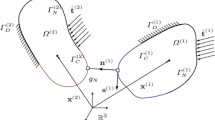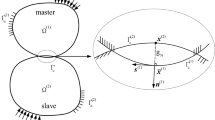Abstract
In many contact situations the material behavior of one contact member strongly influences the force acting between the two bodies. Unfortunately standard friction models cannot reproduce all of these material effects at the contact layer and often continuum interface elements are used instead. These elements are intrinsically tied to the fixed grid and hence cannot be used in large sliding simulations. Due to the shortcomings of the standard contact formulations and of the interface elements a new type of a contact layer element is developed in this work. The advantages of this element are the direct implementation of continuum models into the contact formulation and the application to arbitrary large deformations. Showing a relation between continuum and contact kinematics based on the solid-shell concept the new contact element is at the end a natural extension of the standard contact formulations into 3D. Two examples show that the continuum behavior can be exactly reproduced at the contact surface even in large sliding situations using this contact layer element. For the discretization of the new contact element the Mortar method is chosen exemplary, but it can be combined with all kinds of contact formulations.















Similar content being viewed by others
References
Haraldsson A (2003) Formulierung und simulation der Kontaktvorgänge in der Baugrund-Tragwerk-Interaktion. PhD thesis, Universität Hannover
Ghaboussi J, Wilson EL, Isenberg J (1973) Finite element for rock joints and interfaces. J Soil Mech Found Div 10:833–848
Zaman MM, Desai CS, Drumm EC (1984) Interface model for dynamic soil-structure interaction. J Geotech Eng 110:1257–1273
Lofti HR, Shing PB (1994) Interface model applied to fracture of masonry structures. J Struct Eng 120:63–80
Larsson R, Runesson K (1992) Plastic localization captured by discontinuous displacement approximation. In: Owen DRJ, Onate E, Hinton E (eds) Computational plasticity—fundamentals and applications. Pineridge Press, Swansea, pp 605–616
Miehe C, Schröder J (1994) Post-critical discontinuous localization analysis of small-strain softening elasoplastic solids. Arch Appl Mech 64:267–285
Edlund U (1994) Surface adhesive joint description with coupled elastic-plastic damage behavior and numerical applications. Comput Meth Appl Mech Eng 115:253–276
Benveniste Y (2006) A general interface model for a three-dimensional curved thin anisotropic interphase between anisotropic media. J Mech Phys Solids 54:708–734
Majcherczak D, Dufrnoy P, Nait-Abdelaziz (2005) Third body influence on thermal friction contact problems. J Tribol 127:89–95
Onate E, Celigueta MA, Idelsohn SR, Rossi R (2008) Advances in the particle finite element method for the analysis of fluid-multibody interaction and bed erosion in free surface flow. Comput Methods Appl Mech Eng 197:1777–1800
Wriggers P, Schröder J, Schwarz A (2013) A finite elment method for contact using a third medium. Comput Mech 52:837–847
Oliver J, Hartmann S, Cante JC, Weyler R, Hernandez JA (2009) A contact domain method for large deformation frictional contact problems. Part 1: theoretical basis. Comput Methods Appl Mech Eng 198:2591–2606
Hamrock BJ, Schmid SR, Jacobson BO (2004) Fundamentals of fluid film lubrication, 2nd edn. Marcel Dekker, New York
Curnier AR, Taylor RL (1982) A thermomechanical formulation and solution of lubricated contacts between deformable solids. J Lubr Technol 104:109–117
Haraldsson A, Han CS, Tschöpe H, Wriggers P (1997) Shape optimization of a lubricated journal bearing with regard to the distribution of pressure in the fluid. Eng Optim 29:259–275
Yang B, Laursen TA (2009) A mortar-finite element approach to lubricated contact problems. Comput Methods Appl Mech Eng 198:3656–3669
Weißenfels C, Wriggers P (2015) Methods to project plasticity models onto the contact surface applied to soil structure interactions. Comput Geotech 65:187–198
Schoop H (1986) Oberflächenorientierte Schalentheorie endlicher Verschiebungen. Ingenieur-Archiv 56:427–437
Parisch H (1995) A continuum-based shell theory for non-linear applications. Int J Numer Methods Eng 38:1855–1883
Hauptmann R, Schweizerhof K (1998) A systematic development of ’solid shell’ element formulations for linear and non-linear analysis employing only displacement degrees of freedom. Int J Numer Methods Eng 42:49–69
Klinkel S, Gruttmann F, Wagner W (1999) A continuum based three-dimensional shell element for laminated structures. Comput Struct 71:43–62
Leppin C (1999) Ein diskontinuierliches Finite-Element-Modell für Lokalisierungsversagen in metallischen und granularen Materialien. PhD thesis, Universität Hannover
Ehlers W (1995) A single-surface yield function for geomaterials. Arch Appl Mech 65:246–259
Ehlers W, Scholz B (2007) An inverse algorithm for the identification and the sensitivity analysis of the paramters governing micropolar elasto-plastic granular material. Arch Appl Mech 77:911–931
Puso MA, Laursen TA (2004) A mortar segment-to-segment frictional contact method for large deformations. Comput Methods Appl Mech Eng 193:4891–4913
Hüeber S, Stadler G, Wohlmuth BI (2008) A primal-dual active set algorithm for three-dimensional contact problems with coulomb friction. SIAM J Sci Comput 30:572–596
Tur M, Fuenmayor FJ, Wriggers P (2009) A mortar-based frictional contact formulation for large deformations using Lagrange multipliers. Comput Methods Appl Mech Eng 198:2860–2873
Bernardi C, Debit N, Maday Y (1990) Coupling finite elements and spectral methods: first resuts. Math Comput 54:21–39
Puso MA (2004) A 3D mortar method for solid mechanics. Int J Numer Methods Eng 59:315–336
El-Abbasi N, Bathe K-J (2001) Stability and patch test perfomance of contact discrtizaions and a new soution algorithm. Comput Struct 79:1473–1486
Cyrus M, Beck J (1978) Generalized two- and three-dimensional clipping. Comput Graph 3:23–28
Weißenfels C (2013) Contact methods integrating plasticity models with application to soil mechanics. PhD thesis, Universität Hannover
Yang B, Laursen TA, Meng X (2005) Two dimensional mortar contact methods for large deformation frictional sliding. Int J Numer Methods Eng 62:1183–1225
Sprenger W, Gruttmann F, Wagner W (2000) Delamination growth analysis in laminated structures with continuum based 3D-shell elements and a viscoplstic softeniung model. Comput Methods Appl Mech Eng 185:123–139
Simo JC, Taylor RL (1985) Consistent tangent operators for rate-independent elastoplasticity. Comput Methods Appl Mech Eng 48:101–118
Simo JC (1998) Numerical analysis and simulation of plasticity. Handbook of numerical analysis VI. Elsevier Science B.V, Amsterdam
Wriggers P (2008) Nonlinear finite element methods. Springer-Verlag, Berlin, Heidelberg
Zienkiewicz OC, Taylor RL (1989) The finite element method, volume, vol 1, 4th edn. McGraw Hill, London
Hüeber S, Wohlmuth BI (2005) A primal-dual active set strategy for nonlinear multibody contact problems. Comput Methods Appl Mech Eng 194:3147–3166
Popp A, Gitterle M, Gee MW, Wall WA (2010) Finite deformation frictional mortar contact using a semi-smooth Newton method with consistent linearization. Int J Numer Methods Eng 84:543–571
Author information
Authors and Affiliations
Corresponding author
Rights and permissions
About this article
Cite this article
Weißenfels, C., Wriggers, P. A contact layer element for large deformations. Comput Mech 55, 873–885 (2015). https://doi.org/10.1007/s00466-015-1140-7
Received:
Accepted:
Published:
Issue Date:
DOI: https://doi.org/10.1007/s00466-015-1140-7




